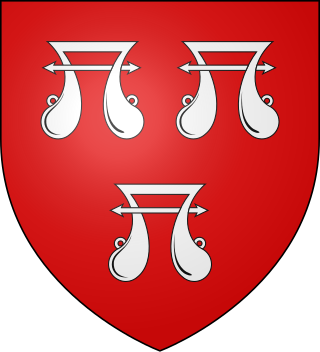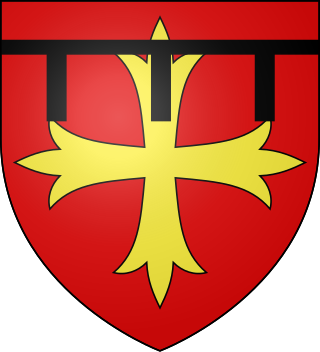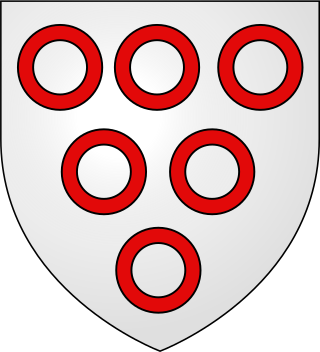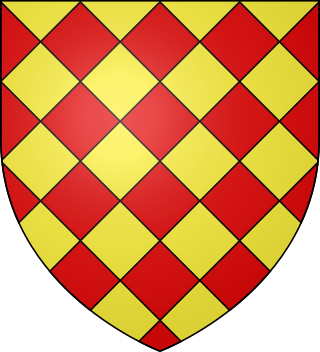
Nicholas Meinill, 1st Baron Meinill [lower-alpha 1] (died 1322), Lord of Whorlton was an English noble. He fought in the wars in Wales and Scotland.

Nicholas Meinill, 1st Baron Meinill [lower-alpha 1] (died 1322), Lord of Whorlton was an English noble. He fought in the wars in Wales and Scotland.
Nicholas was the son of Stephen Meinill. He served in the Welsh and Scotch wars and received the manor of Castle Leavington for services in 1285. Summoned to parliament by writ from 23 June 1295 until 6 February 1299. [1] He married Christian, who in 1290 he accused of attempting to poison him. He died in early 1322. [2] His wife survived him. He was succeeded by his brother John. [3] An illegitimate son Nicholas, by Lucy de Thweng was later summoned to parliament. [4]

William Ros or Roos, 1st Baron Ros of Helmsley, was one of the claimants of the crown of Scotland in 1292 during the reign of Edward I.

Maurice FitzThomas FitzGerald, 1st Earl of Desmond in Dublin Castle, Dublin, Ireland was an Irish nobleman in the Peerage of Ireland, Captain of Desmond Castle in Kinsale, so-called ruler of Munster, and for a short time Lord Justice of Ireland. Called "Maurice the Great", he led a rebellion against the Crown, but he was ultimately restored to favour.
John Butler, Earl of Gowran (1643–1677) was an MP in the Irish Parliament 1661–1666 before being created Earl of Gowran in 1676. He married but died childless.
Baron La Poer, de la Poer, is a title in the Peerage of Ireland held by the Marquess of Waterford. Its creation is the sole instance in the law of the Kingdom of Ireland recognising a peerage by writ.
Sir Valentine Browne, 1st Viscount Kenmare and 3rd Baronet Browne of Molahiffe (1638–1694), was an Irish Jacobite who fought for James II of England in the Williamite War in Ireland.

Thomas Cromwell, 1st Earl of Ardglass, 11 June 1594 to 20 November 1653, was an English nobleman, son of Edward Cromwell, 3rd Baron Cromwell and his second wife Frances Rugge.
Garret Moore, 1st Viscount Moore PC (I) was an Anglo-Irish politician and peer.

Baron Everingham is an abeyant title in the Peerage of England. It was created by Writ of summons to Parliament of Adam de Everingham of Laxton, Nottinghamshire, on 4 March 1309. It passed to his son Adam but fell into abeyance upon the death of his childless grandson Robert in 1371.
John Marmion, Baron Marmion of Winteringham was an Anglo-Norman baron who represented Lincolnshire in Parliament and fought in the Wars of Scottish Independence.

Fulk le Strange, 1st Baron Strange of Blackmere was an English noble. He fought in the wars in Gascony and Scotland. He was a signatory of the Baron's Letter to Pope Boniface VIII in 1301.
Theobald Bourke, 3rd Viscount Mayo was an Irish soldier, landowner, member of the Irish House of Commons, and peer. As Viscount Mayo in the peerage of Ireland, he had a seat in the Irish House of Lords from 1649 until his death.
William Touchet, 1st Baron Touchet, Lord of Lewenhales was an English noble. He fought in the wars in Scotland and Gascony. He was a signatory of the Baron's Letter to Pope Boniface VIII in 1301.

Thomas le Latimer, Lord of Braybrooke was an English noble. He served in English campaigns in France and Scotland.

Hugh de Plessets, Lord of Hooknorton was an English noble. He served in English campaign in Scotland.

Alan de Plugenet, 2nd Baron Plugenet, Lord of Preston Plucknett was an English noble. He served in English campaigns in Scotland.

John Rivers, 1st Baron Rivers, Lord of Aungre was an English noble. He served in English campaigns in Gascony and Scotland. He was a signatory of the Baron's Letter to Pope Boniface VIII in 1301.

Serlo de Lansladron, 1st Baron Lansladron, Lord of Lansladron was an English noble. He fought in the wars in Scotland.

William de Rithre, 1st Baron Rithre, Lord of Rithre was an English noble. He fought in the wars in Gascony and Scotland.

John de Somery, 1st Baron Somery, Lord of Dudley was an English noble. He fought in the wars in Scotland.

Henry de L'Orti, Lord of Curry Revell and Esseleigh was an English noble. He served in English campaigns in Wales and Scotland.